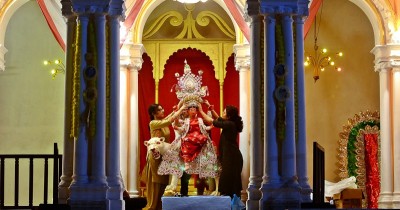
She is having a baby
Johanna Givens has a soothing way of helping women give birth at home. She counts with them -- barely speaking above a whisper -- as they work through the agonizing pain of each contraction.
"When you get into really active, heavy labor, during the contraction, it’s like time stops often, and you are wrapped in this moment of discomfort and unsurety. So we have a counting mechanism” to help them through, said Givens, who works as a doula, providing physical and emotional support to birthing women.
In her seven years on the job in Columbia, Mo., she’s attended the deliveries of more than 50 women who want an alternative to traditional hospital births.
A growing number of American women are taking control of their childbirth by looking for out-of-hospital birthing options, much to the dismay of insurance companies and some medical professionals. In less developed countries such as India, meanwhile, out-of-hospital births are usually not a choice but a necessity -- happening mostly among poor women in remote places who lack access to care. But even in that country, some upper-class women are joining the natural birth trend.
 Jessica Henman CPMIn America, out-of-hospital births are clearly on the rise but far from the norm. According to the U.S. Centers for Disease Control and Prevention, the proportion of births happening outside hospitals started to climb in 2004, rising from 1 percent then to 1.5 percent in 2015 -- or 61,000 births.
Jessica Henman CPMIn America, out-of-hospital births are clearly on the rise but far from the norm. According to the U.S. Centers for Disease Control and Prevention, the proportion of births happening outside hospitals started to climb in 2004, rising from 1 percent then to 1.5 percent in 2015 -- or 61,000 births.
In India, out-of-hospital births are far more common. UNICEF statistics show 53 percent of women gave birth outside of an institution in 2012.
For women lucky enough to have a choice, experts say many are driven by a desire to make life processes like childbirth more natural instead of treating them like medical conditions.
"A lot of women are talking about it,” Givens said. “They’re talking about the breastfeeding movements. They’re talking about the choice movements, the movements of letting our bodies naturally process.”
 Johanna Givens Birth and choice in America
Johanna Givens Birth and choice in America
In Givens’ home state of Missouri, out-of-hospital births have roughly doubled in 10 years.
While this includes the occasional surprise delivery in an ambulance, it mostly reflects births at home or in birthing centers.
“Option is important and choice is important,” Givens said. “This is their body in which they’re going to be doing majority of the work and the consequences of what happens during that birth can last her lifetime and the child’s lifetime.”
 Birthing centers, which are generally associated with hospitals, offer a sort of middle ground. One, at the Missouri Women’s and Children’s Hospital in Columbia, started as part of the hospital’s low-intervention program in 2015. Women decide whether they want care from a certified nurse midwife or an obstetrician, and must meet guidelines showing their pregnancies are low-risk and not expected to need emergency interventions.
Birthing centers, which are generally associated with hospitals, offer a sort of middle ground. One, at the Missouri Women’s and Children’s Hospital in Columbia, started as part of the hospital’s low-intervention program in 2015. Women decide whether they want care from a certified nurse midwife or an obstetrician, and must meet guidelines showing their pregnancies are low-risk and not expected to need emergency interventions.
Jessica Henman is a certified nurse midwife at a similar but free-standing facility in O’Fallon, Mo., called the Birth and Wellness Center.
 Natalie and Naomie CNMs have collaborative agreements with physicians, and Henman’s agreement is with Dr. Jeffrey Mormol at the Missouri Baptist Medical Center, a 25 minute drive away.
Natalie and Naomie CNMs have collaborative agreements with physicians, and Henman’s agreement is with Dr. Jeffrey Mormol at the Missouri Baptist Medical Center, a 25 minute drive away.
“Not all women can give birth without medical intervention, so we’re glad we have the partnership with the hospital, so we can do that when we need to,” Henman said. “We like that about 90 percent of our moms don’t need the hospital, and if you look at research for the right kind of woman, for a low-risk mother with a single baby, head down, no medical history, she might actually be safer outside the hospital than in it.”
But some doctors are skeptical about out-of-hospital births, particularly those in homes. Dr. Ravi Johar, an ob/gyn in St. Louis, said when something goes wrong with a pregnancy at home, he knows of instances when midwivessimply dropped birthing moms at the emergency room and left.
 Natalie and Naomie “...Or they’re told to drive themselves in and there’s usually a ‘we don’t want them to know we’re involved,’ which is a problem because now you have no history to go with them,” he said. “Every obstetrician has anecdotal stories of all kinds of things.”
Natalie and Naomie “...Or they’re told to drive themselves in and there’s usually a ‘we don’t want them to know we’re involved,’ which is a problem because now you have no history to go with them,” he said. “Every obstetrician has anecdotal stories of all kinds of things.”
Births at home are usually attended by certified nurse midwives, certified professional midwives or doulas. CPMs don’t have to have any formal education, although they must be certified by the North American Registry of Midwives. Doulas don’t need formal education either, but can get voluntary training and certification.CNMs, on the other hand, must have nursing degrees.
There’s a lot of disagreement on which type of birth is safer. One study in Oregon, which has the nation’s highest rate of home births, showed that the perinatal mortality for out-of-hospital births was about twice as high as the hospital average.
But American women giving birth in hospitals are more likely to undergo cesarean sections, which come with risks such as infection and blood loss. According to study published in JAMA in 2015, cesarean delivery rates of up to about 19 percent are associated with lower maternal and infant deaths. The U.S. rate that year was 32 percent.
 Natalie Mothers-to-be weigh safety considerations while also considering the quality of the birth experience. Jessica Bevans, who has three daughters, has been through it all. Her first child was born at a birthing clinic, the second at Boone Hospital Center and the third at home.
Natalie Mothers-to-be weigh safety considerations while also considering the quality of the birth experience. Jessica Bevans, who has three daughters, has been through it all. Her first child was born at a birthing clinic, the second at Boone Hospital Center and the third at home.
“I decided to be home because I wanted to be able to focus on the pain and be able to relax through the pain,” Bevans said.
 O'Fallon Birthing Center“I guess I just learned things from midwives more than I did in the hospital. They were definitely more educational—like caring about you and yourwell being and making sure you know that everything is OK and safe. Whereas, compared to the hospital, it was just kind of like procedure—like a medical procedure—where I feel like (giving) birth is not a medical procedure. But I wasn’t high-risk, and if I was high-risk, I probably would have chose a hospital.”’
O'Fallon Birthing Center“I guess I just learned things from midwives more than I did in the hospital. They were definitely more educational—like caring about you and yourwell being and making sure you know that everything is OK and safe. Whereas, compared to the hospital, it was just kind of like procedure—like a medical procedure—where I feel like (giving) birth is not a medical procedure. But I wasn’t high-risk, and if I was high-risk, I probably would have chose a hospital.”’
Insurance companies generally side with hospitals when it comes to safety. Aetna’s policy says “planned deliveries at home and associated services are not medically appropriate.” It references the American College of Obstetricians and Gynecologists, which says midwifery presents hazards to both mom and child.
“The majority of my clients come to me and they need that happy medium,” Givens said. “I do home births and hospital births, and the ones that choose the hospital birth but still want to go the more natural route are doing so because of insurance purposes and finances.”
 Indian Midwife explains birthing to a would be motherBirth and economics in India
Indian Midwife explains birthing to a would be motherBirth and economics in India
In India, home births can be especially dangerous. That’s because so many happen among poor women in rural areas who lack access to care and rely on untrained midwives during delivery. A 2010 study by the Harvard School of Public Health showed 150,000 deaths in India could have been prevented by 2015 if women had better access to care during their pregnancies and deliveries.
Vidhi Beri, a lactation specialist and child nutrition counselor in India, said traditional midwives get informal training handed down through generations, but aren’t updated about advancements in birthing techniques.
In a small village in central India in the Hoshangabad district in Madhya Pradesh, midwifery is a tradition for Sima Kumari,70, whose mother and grandmother were also midwives.
 She took government classes training her in natural treatment, hygiene and health, and accompanied her mother as she worked.
She took government classes training her in natural treatment, hygiene and health, and accompanied her mother as she worked.
She said the process can sometimes be risky if the pregnancy is complicated and she has to take the mom to a hospital.
“In majority times the patient dies while travelling, before even reaching the hospital because the hospitals are very far from the villages,” she said.
Samir Chakraborty, a gynecologist from Kolkata, India, said midwives’ lack of specialization makes home births unsafe. Any medical complications can be deadly.
The risks are much different for Indian women higher on the income scale.
Women among India’s growing middle class are getting more C-sections these days -- and facing the complications that come along with them. Indian health officials claim this is partly because of pressure from doctors at private hospitals, which are paid more for surgical procedures. Women who may not know much about the risks of C-sections tend to take their doctors’ advice.
But wealthier, more educated women in India are starting to push for more natural deliveries -- both in the hospital and, increasingly, at home.
And those home births benefit from well-trained and paid helpers unavailable to the poor.
Ultimately, there’s no clear answer as to the best place to give birth. But mothers and health workers in both India and the United States agree that women should ideally be able to choose-- and get all the support they need to deliver healthy babies.
When everything goes right, Givens said, the experience of pregnancy and childbirth can be amazing for mothers. “It’s unbelievable to see the body change and grow and blossom, and then all this power be put forth into having this new life.”
(Additional contribution and Multimedia by Rachel Thomas)
India Blooms New Service-Trans World Features (IBNS-TWF)
(A University of Missouri and IBNS-TWF Collaboration Series Article)
Support Our Journalism
We cannot do without you.. your contribution supports unbiased journalism
IBNS is not driven by any ism- not wokeism, not racism, not skewed secularism, not hyper right-wing or left liberal ideals, nor by any hardline religious beliefs or hyper nationalism. We want to serve you good old objective news, as they are. We do not judge or preach. We let people decide for themselves. We only try to present factual and well-sourced news.







